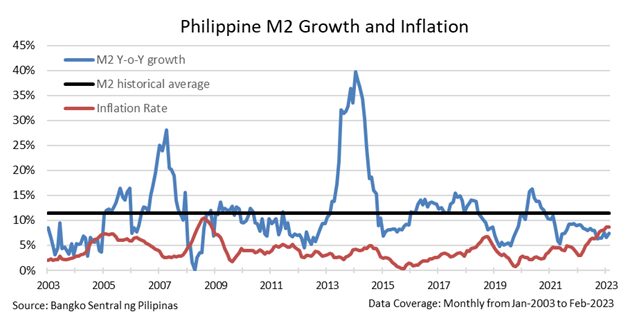PH Monday Macro: Money supply is pushing inflation up

In the last macro report, we talked about the different inflation measurements and what industries are pushing the figure. Today, we will talk about one of the tools of the central bank that are causing inflation to rise.
Philippine Markets Daily:
The Monday Macro Report
Powered by Valens Research
The Bangko Sentral ng Pilipinas (BSP) has two mandates: price stability and full employment. These two ordinances dictate monetary policy. To achieve its goals for each decree, the central bank has a box of tools that it utilizes. One of them is the money supply in the system.
To purchase any goods or services, we use money. Since the economy is based on the exchange of money and goods and services, the economy runs on the money supply.
There are four types of money supply – currency & transferable deposits (M1), currency outside depository corporations and deposits (M2), domestic liquidity (M3), and total liquidity aggregates (M4).
Among all types, M2 is commonly used as a gauge for inflation because it measures liquidity, such as short-term time deposits, money market funds, and the total amount of currency circulating (M1).
When money supply grows faster than the economy’s ability to produce goods and services, it causes inflation. On the other hand, when money supply does not match the level of growth, this results in a lower output which in turn can lead to a decline in unemployment. Hence, why it could be used as an indicator of inflation and, to an extent, economic growth.
Historically, in the Philippines, except for one case, inflation rises each time the BSP injects money above a 10% month-over-month (m-o-m) growth rate.

In response to the high quarterly GDP growth rate between 5.5% and 7.5% in 2004, to meet the level of such expansionary output, the central bank started to increase the money supply in the following year, in 2005.
In the same year, there were supply-side inflationary pressures due to the effects of El Nino (that limited food supply) and the global rise in oil prices. This led the BSP to ease injecting money into the system in Q1 2006. Subsequently, economic growth started to advance and led the central bank to take the same course of increasing money supply to match economic output.
Then in 2008, the global financial crisis started to materialize. Due to fears of spillover and financial contagion, BSP took its foot off the pedal and remained cautious about injecting money into the economy.
In Q1 of 2008, GDP contracted by 1.6%, and money supply was almost muted. The extra money that was floating around in the system led to an inflation spike from 4.6% in January 2008 to 10.50% in August of the same year.
Furthermore, we’ve seen how money supply can cause inflation if the supply is greater than the output. Yet, there are some cases where money supply parallels Philippine economic growth. This could be observed from 2013 to 2014.
2012 Philippine economic performance ranged from 6.0% to 7.8%. The high growth rate pressed the central bank to dramatically increase the money supply in 2013 and 2014. Since the money supply m-o-m growth corresponded to the economy’s development rate, inflation did not rise like what we saw in 2008.
Nevertheless, as mentioned earlier, inflation inches up when the central bank increases M2, and it is above 10%. The expansion of money from 2005-2007 led to elevated inflation in 2008. Similar cases happened when money rose greater than the output from 2016 to late 2018, and inflation rose to 6.7%.
Due to the pandemic, the BSP intervention and quantitative easing increased money supply, surpassing a 10% growth m-o-m for more than a year. As a result, today, we have a record-breaking inflation figure of 8.7% in January earlier this year.
Although the M2 supply can not tell us how long inflation will persist, it tells us that more money is circulating in the system, and that the growth is greater than the economic output. This is why the BSP has been increasing interest rates and has a hawkish policy.
About the Philippine Markets Newsletter
“The Monday Macro Report”
When just about anyone can post just about anything online, it gets increasingly difficult for an individual investor to sift through the plethora of information available.
Investors need a tool that will help them cut through any biased or misleading information and dive straight into reliable and useful data.
Every Monday, we publish an interesting chart on the Philippine economy and stock market. We highlight data that investors would normally look at, but through the lens of Uniform Accounting, a powerful tool that gets investors closer to understanding the economic reality of firms.
Understanding what kind of market we are in, what leading indicators we should be looking at, and what market expectations are will make investing a less monumental task than finding a needle in a haystack.
Hope you’ve found this week’s macro chart interesting and insightful.
Stay tuned for next week’s Monday Macro report!
Regards,
Angelica Lim
Research Director
Philippine Markets Newsletter
Powered by Valens Research
www.valens-research.com




